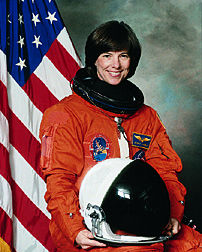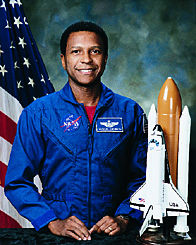Prelude
Heavens Above
The University of Washington has always reached for the stars. When the UW moved to its Montlake campus in 1895, it opened two buildings—Denny Hall for teaching and the Observatory for research. Since that time, UW faculty and alumni in astronomy, engineering, physics, medicine, atmospheric sciences and other departments have made major contributions to space exploration.

UW alumni Bonnie Dunbar, '71, '75.
Throughout the history of the space program, our alumni have pushed back the boundaries of the final frontier. Scott Crossfield, '49, '50, an alumnus of the College of Engineering, was a high-speed test pilot for the U.S. military. On Nov. 20, 1953, he was the first person to fly at Mach 2—twice the speed of sound—and he later flew the X-15, an experimental rocket plane that was crucial to the U.S. space program.
Once we started sending astronauts into space, UW alumni were ready for liftoff. Seven have been astronauts: Michael Anderson, '81; Yvonne Cagle, '85; Bonnie Dunbar, '71, '75; John Fabain, '74; Richard Gordon, '51; Janet Kavandi, '90; and George (Pinky) Nelson, '74, '78. Gordon bears the distinction of being the alumnus who has traveled the farthest from his alma mater—he circled the Moon in Apollo 12.

UW alumni Michael Anderson, '81.
On the ground, George W. Jeffs, '45, '48, was the chief engineer for the Apollo space program at North American Aviation and was part of a team that won the 1970 Presidential Medal of Freedom for rescuing the astronauts on the ill-fated Apollo 13 mission.
Meanwhile, UW research has also contributed to the space program. Ceramics Engineering Professor Jim Mueller helped test the ceramic tiles for the Space Shuttle—making certain they could withstand the tremendous temperatures at re-entry. In the early 1980s, Atmospheric Sciences Research Professor Jim Tillman transformed computer data from the Viking mission to Mars into a "Live From Mars" image that was broadcast to the Smithsonian National Air and Space Museum in Washington, D.C., and used in K-12 education.
Currently, Astronomy Professor Donald Brownlee, '71, is the head scientist on the Stardust mission, which hopes to bring "comet dust" back to Earth. NASA launched its spacecraft in 1999 to rendezvous with Comet Wild 2 in 2004—when it is merely 242 million miles from Earth. The spacecraft should bring back its samples two years later, perhaps unlocking the secrets of the origin of life on our planet.
The University is also a key member of the Sloan Digital Sky Survey, the most ambitious astronomical survey project ever undertaken. Scientists hope to map one-quarter of the entire sky, determining the positions and brightness of more than 100 million celestial objects. The survey will also record the distances to 100,000 quasars, the most distant objects known, giving us a hint of what lies at the edge of the universe. All of this is in addition to the UW's biomedical research for space travelers, which is the topic of our cover story.
When bricklayers set the sandstone blocks of the UW Observatory 106 years ago, they may not have realized they were also building stepping stones to the exploration of outer space. Today's faculty and tomorrow's alumni are sure to contribute to space exploration as well. Wherever they lead us, it's going to be a fascinating ride.
TOM GRIFFIN, Editor
|
 THE UNIVERSITY OF WASHINGTON ALUMNI MAGAZINE
THE UNIVERSITY OF WASHINGTON ALUMNI MAGAZINE
 THE UNIVERSITY OF WASHINGTON ALUMNI MAGAZINE
THE UNIVERSITY OF WASHINGTON ALUMNI MAGAZINE
